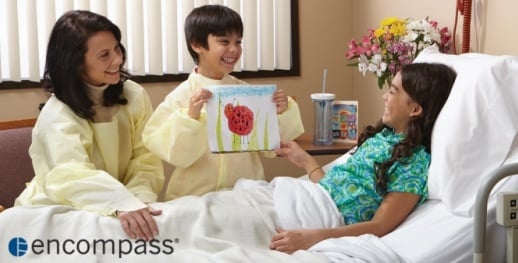Do your patients frequently complain of apparel-related modesty issues? Is it negatively affecting their experience and your patient satisfaction scores? Improve patient comfort with apparel that keeps them fully covered.

Three Questions to Uncover How Apparel Impacts Patient Satisfaction
Every acute care facility strives to offer a high-quality patient experience. When the Centers for Medicare & Medicaid Services began to tie reimbursements to HCAHPS (Hospital Consumer Assessment of Healthcare Providers and Systems) scores, the need to provide the best patient experience possible became a financial priority as well.
The HCAHPS Survey is a 7-minute survey that a random panel of patients are asked to complete between 8 hours and six weeks after discharge. The survey is composed of 27 questions about their hospital stay, most of which are directly related to patient experience and satisfaction.
The important thing to remember when thinking about how to improve the patient experience at your facility is to consider the idea that patients care about more than just the procedure they receive or how much time the clinical staff spend in their room; when answering questions about their experience, they recall how they felt through their entire experience at your facility from entry to exit, down to the details.
Patients arriving at the hospital are already stressed thinking about their diagnosis or approaching procedure. The last thing any hospital caregiver wants is for the patient to feel even more uncomfortable due to the apparel they are asked to wear. Below are three questions all caregivers should ask themselves when supplying patients with apparel to wear during their stay at your facility:
Does this patient apparel fit this patient properly?
Hospital patients come in all different sizes, heights and body shapes. It’s unrealistic to think that a “one size fits all” approach is possible when the patient population is so diverse. Even offering patients a standard gown in small, medium or large no longer suffices as obesity rates continue to rise in the United States. For example: standard size hospital gowns with a tie at the waist commonly fail to properly cover overweight or obese patients. A plus-size patient gown with a full overlap that ties at the neck will allow the gown to hang properly on different sized patients. By carrying patient apparel sizes from extra small up to 10XL, a hospital is ensuring that patients aren’t singled-out due to their size.
Properly-designed patient apparel also ensures patient modesty – a huge factor in the patient experience and satisfaction. Ties that fasten on the side or closer to the front of the gown make it easier for patients to adjust on their own, and give them a secure feeling of control.Patients may rate their comfort by how they feel in their gowns. Be sure your gowns are designed to preserve modesty at a time when they feel most vulnerable.

Is the quality of this patient apparel up to our facility standards?
Patients need apparel that is comfortable, durable and non-transparent. A reusable patient gown offers a softer touch and better modesty than compared to the materials used in a disposable patient gown, which have a tendency to be uncomfortable and somewhat transparent. A reusable patient gown is also more durable, whereas a disposable patient gown is more susceptible to tearing or snagging. Reusable textiles are also more patient-friendly and less intimidating, thus improving the patient experience.
If your facility already has a stock of reusable patient apparel, checking the integrity of the products is important. Apparel with holes or loose seams should be removed from inventory to prevent them from failing while a patient is wearing them. Textiles should also be inspected for stains so that patients can be confident that their apparel has been properly laundered to prevent the risk of cross-contamination from previous patients.
Is this apparel age-appropriate?
Most hospitals offer varying patient apparel sizes to accommodate the widespread size range of today’s pediatric patients. Unfortunately, the standard sizing used in the pediatric arena doesn’t always fit the older children or teens experiencing their growth spurt. Rather than squeezing an adolescent into a pediatric gown or draping them in an adult patient gown, hospitals should purchase teen-sized gowns for maximum comfort and coverage.
Hospitals may also consider incorporating pediatric patient apparel with fun, whimsical prints. The exciting visuals would help distract a child and put their mind at ease thus making their hospital experience more comfortable. This simple concept will increase their ability to cope and communicate, which is imperative in the medical setting and important for improving the patient’s and their family’s satisfaction with the hospital visit.
Protecting patient modesty and improving comfort doesn’t only increase care quality, it also can increase patient satisfaction within your facility. A positive patient experience is imperative for protecting your facility’s HCAHPS scores, and therefore, your reimbursements.
Encompass Group LLC has a large variety of patient apparel options to meet the needs of your patients. Learn more about how to protect patient modesty and improve patient satisfaction by calling 1-800-284-4540 or emailing me today!

